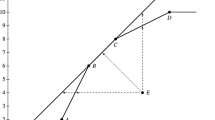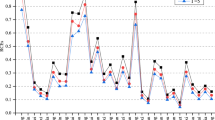Abstract
In real applications, data envelopment analysis models with Russell measures are widely used although their theoretical studies are scattered over the literature. They often have seemingly similar structures but play very different roles in performance evaluation. In this work, we systematically examine some of the models from the viewpoint of preferences used in their production possibility sets (PPS). We identify their key differences through the convexity and free-disposability of their PPS. We believe that this study will provide guidelines for the correct use of these models. Two empirical cases are used to compare their differences.


Similar content being viewed by others
References
Aparicio, J., & Pastor, J. T. (2013). A well-defined efficiency measure for dealing with closest targets in DEA. Applied Mathmatics and Computation, 219(17), 9142–9154.
Bogetoft, P., & Hougaard, J. (1999). Efficiency evaluations based on potential (non-proportional) improvements. Journal of Productivity Analysis, 12(3), 233–247.
Charnes, A., Cooper W. W., & Rhodes, E. (1978). Measuring the efficiency of decision making units. European Journal of Operational Research, 2, 429–444.
Chen, Y., & Sherman, D. H. (2004). The benefits of non-radial vs. radial super-efficiency DEA: an application to burden-sharing amongst NATO member nations. Socio-Economic Planning Sciences, 38, 307–320.
Coelli, T. J., Prasada Rao, D. S., O’Donnell, C. J., & Battese, G. E. (2005). An introduction to efficiency and productivity analysis (2nd ed.). New York: Springer Science Business Media, LLC.
Cook, W. D., & Joe, Z. (2007). Modeling data irregularities and structural complexities in data envelopment analysis. New York: Springer.
Cooper, W. W., Huang, Z., Li, S. X., Parker, B. R., & Pastor, J. T. (2007a). Efficiency aggregation with enhanced Russell measures in data envelopment analysis. Socio-Economic Planning Sciences, 41, 1–21.
Cooper, W. W., Seiford, L. M., & Joe, Z. (2004). Handbook on data envelopment analysis. Boston: Kluwer Academic Publishers.
Cooper, W. W., Seiford, L. M., & Tone, K. (2006). Introduction to data envelopment analysis and its uses. New York: Springer.
Cooper, W. W., Seiford, L. M., & Tone, K. (2007b). Data envelopment analysis: a comprehensive text with models, applications, references and DEA-Solver software (2nd ed.). New York: Springer.
Fare, R., & Lovell, C. A. K. (1978). Measuring the technical efficiency of production. Journal of Economic Theory, 19, 150–162.
Levkoff, S. E., Russell, R. R., & Schworm, W. (2012). Boundary problems with the “Russell” graph measure of technical efficiency: a refinement. Journal of Productivity Analysis, 37, 239–248.
Liu, P. L. (1985). Multiple decision making. New York: Plenum.
Liu, W. B., Meng, W., Li, X. X., & Zhang, D. Q. (2010). DEA models with undesirable inputs and outputs. Annals of Operations Research, 173, 177–194.
Liu, W. B., Sharp, J., & Wu, Z. M. (2006). Preference, production and performance in data envelopment analysis. Annals of Operations Research, 145, 105–127.
Liu, W. B., Zhang, D. Q., Meng, W., Li, X. X., & Xu, F. (2011). A study of DEA models without explicit inputs. Omega, 39, 472–480.
Liu, W. B., Zhou, Z. B., Liu, D. B., & Xiao, H. (2015a). Estimation of portfolio efficiency via DEA. Omega, 52, 107–118.
Liu, W. B., Zhou, Z. B., Ma, C. Q., Liu, D. B., & Shen, W. F. (2015b). Two stage DEA models with undesirable input-intermediate-outputs. Omega, 56, 74–87.
Mirsalehy, A., Bakar, M. R. A., Jahanshahloo, G. R., Lotfi, F. H., & Lee, L. S. (2016). Centralized resource allocation for connecting radial and non-radial models. Journal of Applied Mathematics, 6, 1–12.
Pastor, J. T., Ruiz, J. L., & Sirvent, I. (1999). An enhanced DEA Russell graph efficiency measure. European Journal of Operational Research, 115, 596–607.
Ray, S. C. (2004). Data envelopment analysis theory and techniques for economics and operations research. New York: Cambridge University Press.
Russell, R. R., & Schworm, W. (2009). Axiomatic foundations of efficiency measurement on data-generated technologies. Journal of Productivity Analysis, 31, 77–86.
Schaefer, H. H., & Wolff, M. P. (1999). Topological vector spaces (2nd ed.). New York: Springer.
Seiford, L. M., & Joe, Z. (1998). Identifying excesses and deficits in Chinese industrial productivity (1953-1990): a weighted data envelopment analysis approach. Omega, 26, 279–296.
Seiford, L. M., & Joe, Z. (2003). Context-dependent data envelopment analysis–Measuring attractiveness and progress. Omega, 31, 397–408.
Tone, K. (2001). A slack-based measure of efficiency in data envelopment analysis. European Journal of Operational Research, 130, 498–509.
Zhang, D. Q., Li, X. X., Meng, W., & Liu, W. B. (2009). Measuring the performance of nations at the Olympic Games using DEA models with different preferences. Journal of the Operational Research Society, 60, 983–990.
Zhou, Z., Sun, L., Yang, W., Liu, W., & Ma, C. (2013). A bargaining game model for efficiency decomposition in the centralized model of two-stage systems. Computers & Industrial Engineering, 64, 103–108.
Zhu, J. (1996). Data envelopment analysis with preference structure. The Journal of the Operational Research Society, 47, 136–150.
Zhu, J. (1998). Data envelopment analysis vs. principal component analysis: An illustrative study of economic performance of Chinese cities. European Journal of Operational Research, 111, 50–61.
Zhu, J. (2009). Quantitative models for performance evaluation and benchmarking: Data envelopment analysis with spreadsheets and DEA excel solver (2nd ed.). New York: Springer.
Zhu, J., & Cook, W. D. (2007). Modeling data irregularities and structural complexities in data envelopment analysis. New York: Springer.
Acknowledgements
The authors would like to thank the support of the National Natural Science Foundation of China (Nos. 71771082, 71371067, 11501326) and Hunan Provincial Natural Science Foundation of China (No. 2017JJ1012).
Author information
Authors and Affiliations
Corresponding author
Rights and permissions
About this article
Cite this article
Shen, W., Yang, G., Zhou, Z. et al. DEA models with Russell measures. Ann Oper Res 278, 337–359 (2019). https://doi.org/10.1007/s10479-018-2867-2
Published:
Issue Date:
DOI: https://doi.org/10.1007/s10479-018-2867-2




